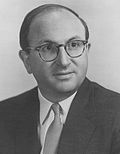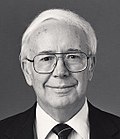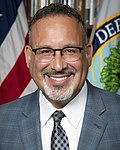| United States Secretary of Education | |
|---|---|
 Seal of the Department of Education | |
 Flag of the secretary | |
| Department of Education | |
| Style | Madam Secretary (informal) The Honorable (formal) |
| Member of | Cabinet of the United States |
| Reports to | President of the United States |
| Seat | Lyndon Baines Johnson Department of Education Building Washington, D.C. |
| Appointer | The president with Senate advice and consent |
| Term length | No fixed term |
| Constituting instrument | 20 U.S.C. § 3411 |
| Formation | November 30, 1979 |
| First holder | Shirley Hufstedler |
| Succession | Sixteenth [1] |
| Deputy | Deputy Secretary |
| Salary | Executive Schedule, Level I |
| Website | ed.gov |
The United States secretary of education is the head of the United States Department of Education. The secretary serves as the principal advisor to the president of the United States, and the federal government, on policies, programs, and activities related to all education in the United States. As a member of the Cabinet of the United States, the secretary is sixteenth in the line of succession to the presidency. [2] Prior to its creation as an Executive Department, there was a non-Cabinet level position called the United States commissioner of education who led the United States Office of Education.
Contents
- Function
- List of secretaries
- Health, Education, and Welfare
- Education
- See also
- References
- External links
The current secretary of education is Linda McMahon, serving in this role under President Donald Trump. [3]































